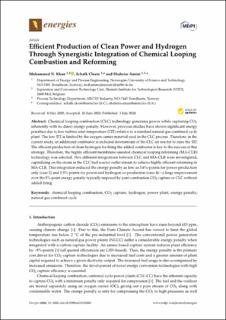Efficient Production of Clean Power and Hydrogen Through Synergistic Integration of Chemical Looping Combustion and Reforming
Peer reviewed, Journal article
Published version
Permanent lenke
https://hdl.handle.net/11250/2996236Utgivelsesdato
2020Metadata
Vis full innførselSamlinger
- Publikasjoner fra CRIStin - SINTEF AS [5654]
- SINTEF Industri [1534]
Sammendrag
Chemical looping combustion (CLC) technology generates power while capturing CO2 inherently with no direct energy penalty. However, previous studies have shown significant energy penalties due to low turbine inlet temperature (TIT) relative to a standard natural gas combined cycle plant. The low TIT is limited by the oxygen carrier material used in the CLC process. Therefore, in the current study, an additional combustor is included downstream of the CLC air reactor to raise the TIT. The efficient production of clean hydrogen for firing the added combustor is key to the success of this strategy. Therefore, the highly efficient membrane-assisted chemical looping reforming (MA-CLR) technology was selected. Five different integrations between CLC and MA-CLR were investigated, capitalizing on the steam in the CLC fuel reactor outlet stream to achieve highly efficient reforming in MA-CLR. This integration reduced the energy penalty as low as 3.6%-points for power production only (case 2) and 1.9%-points for power and hydrogen co-production (case 4)—a large improvement over the 8%-point energy penalty typically imposed by post-combustion CO2 capture or CLC without added firing

